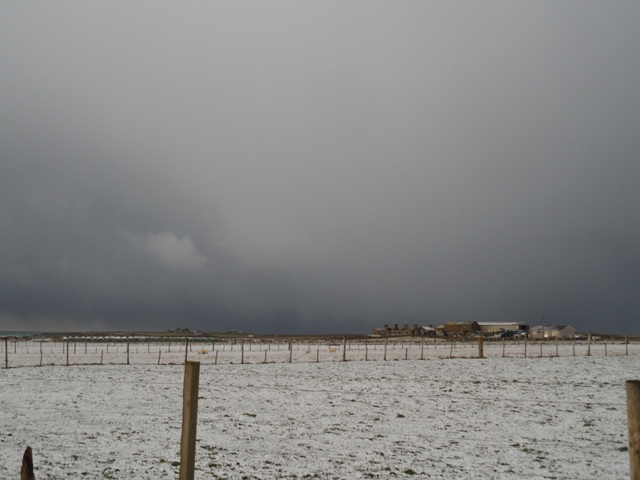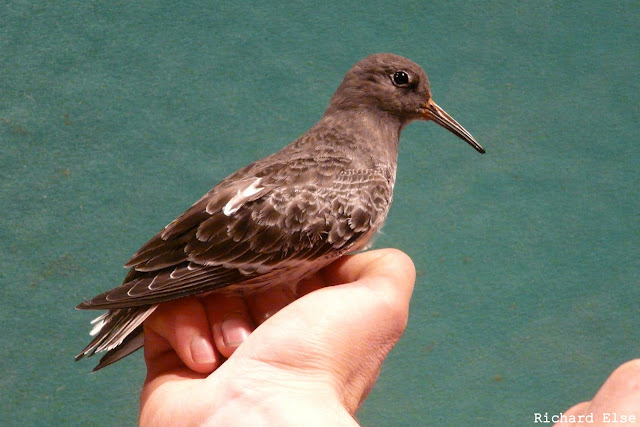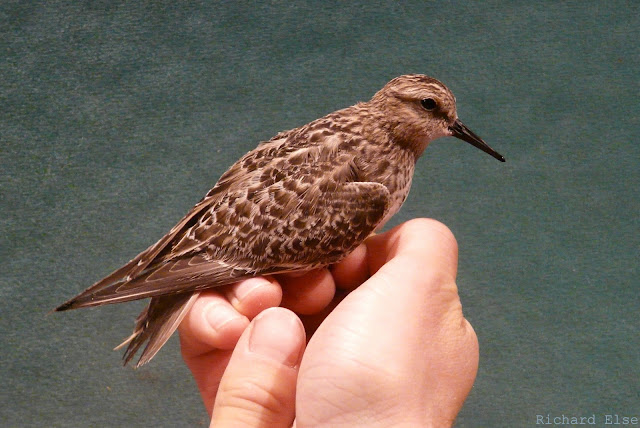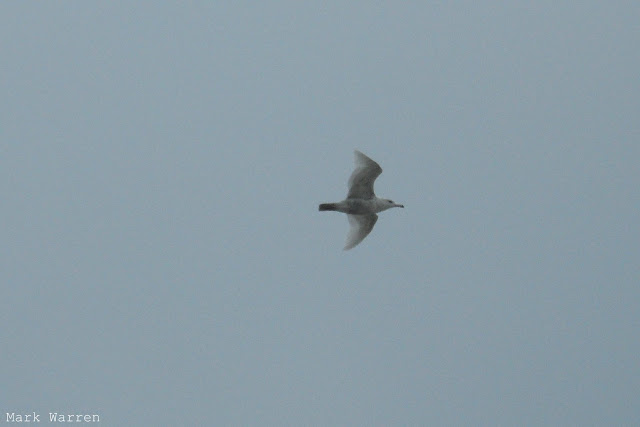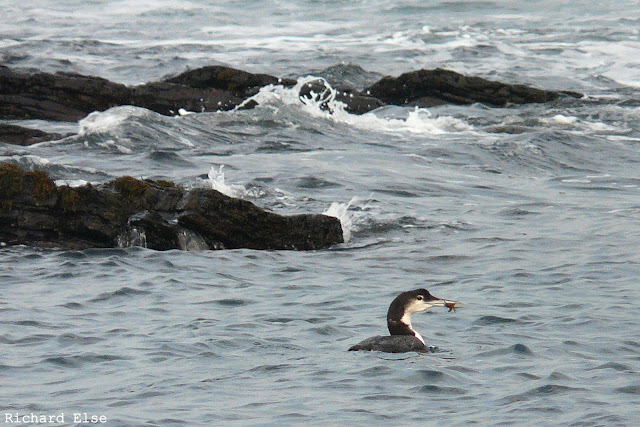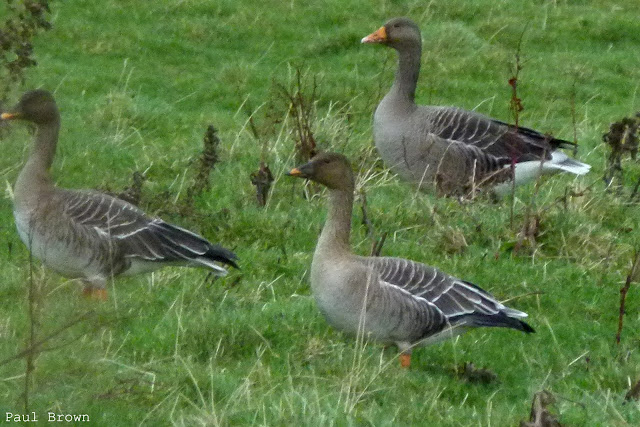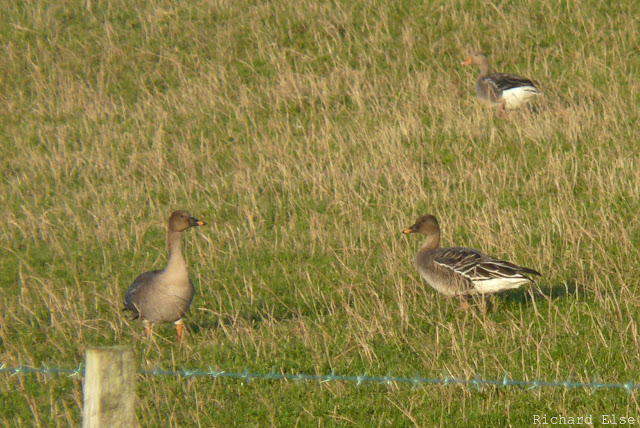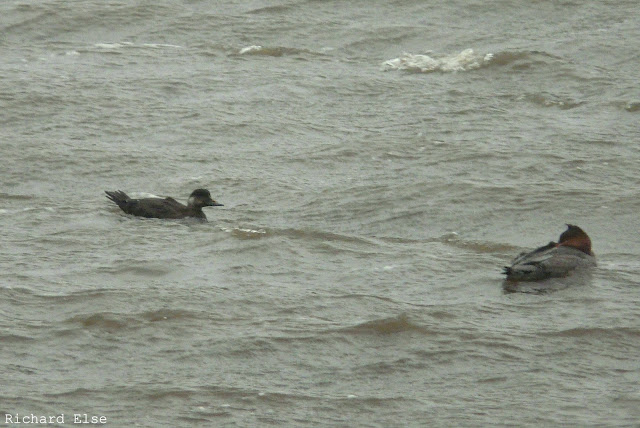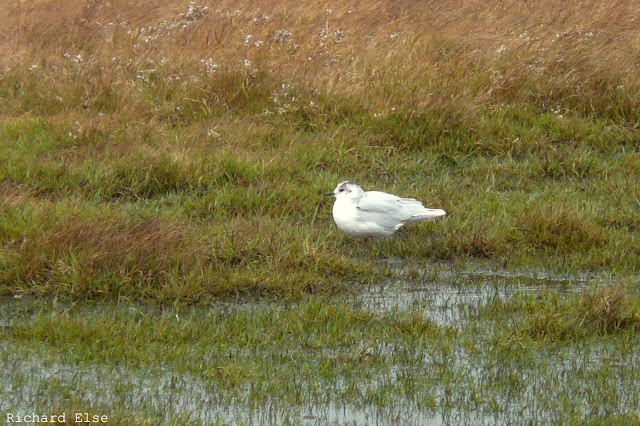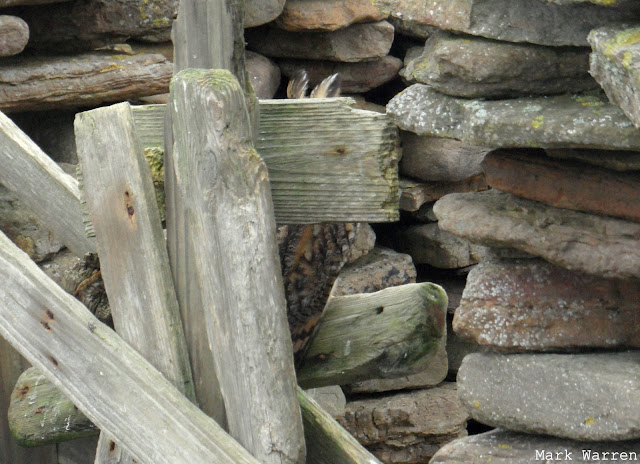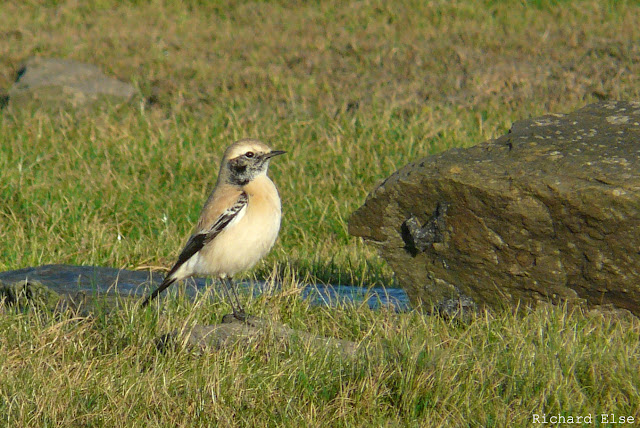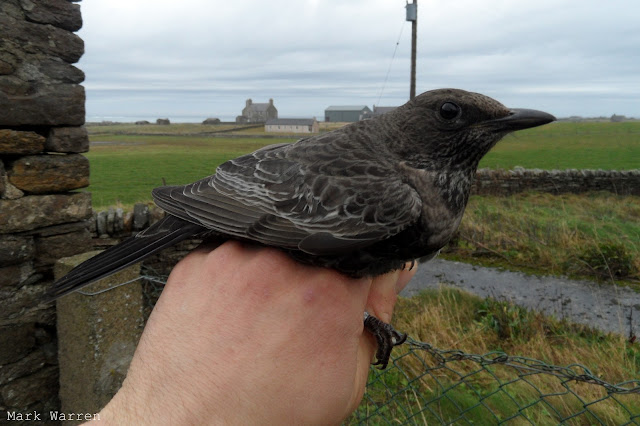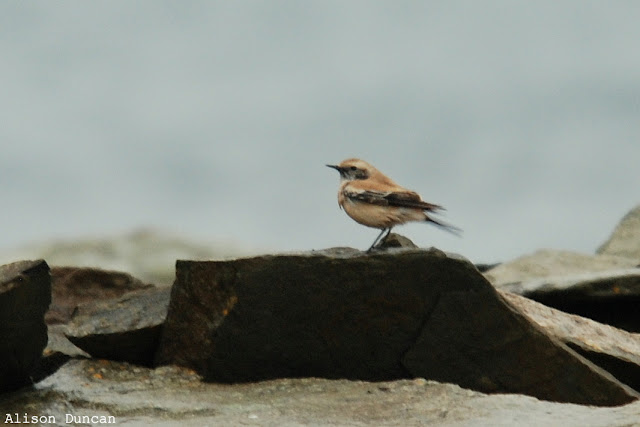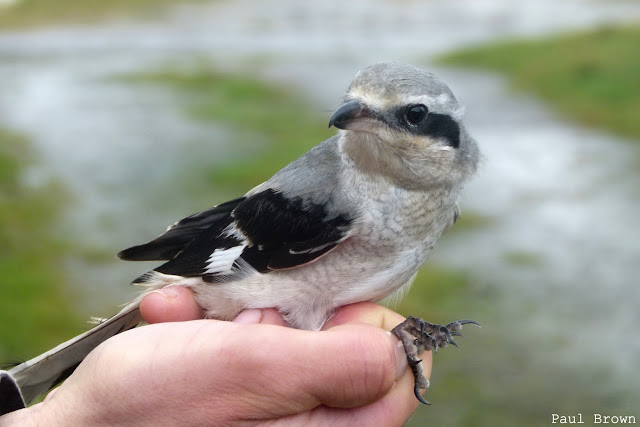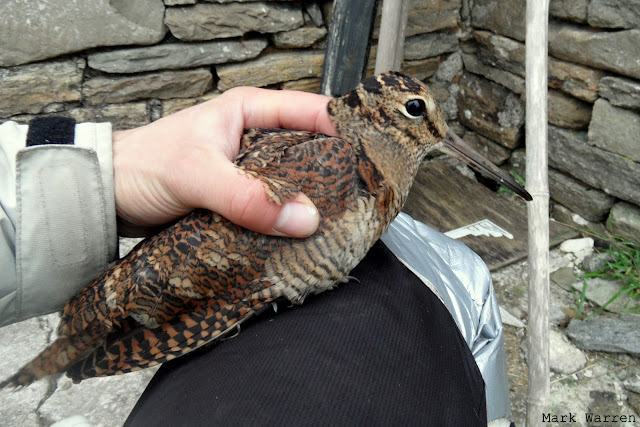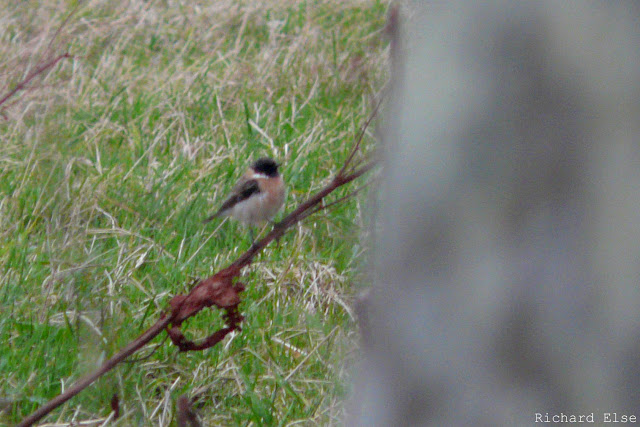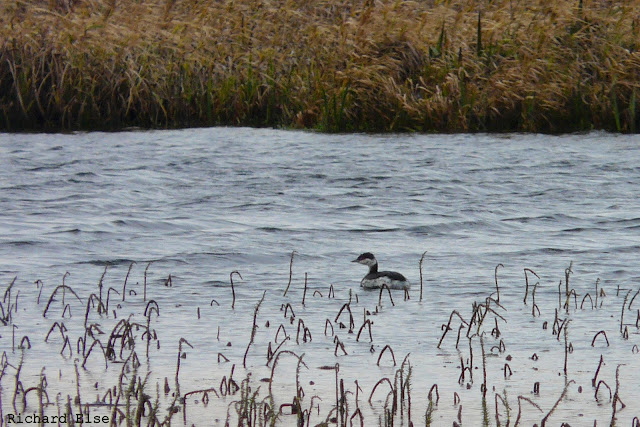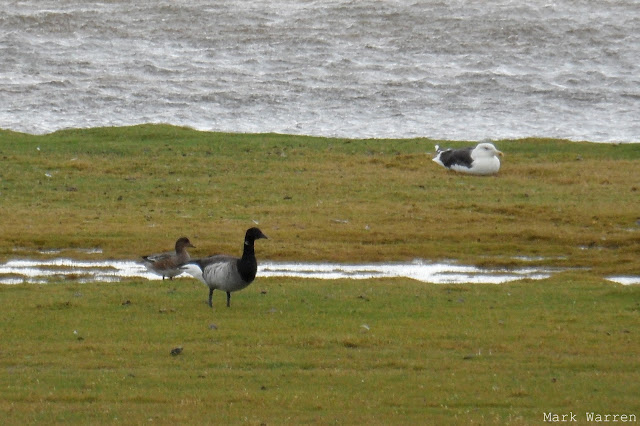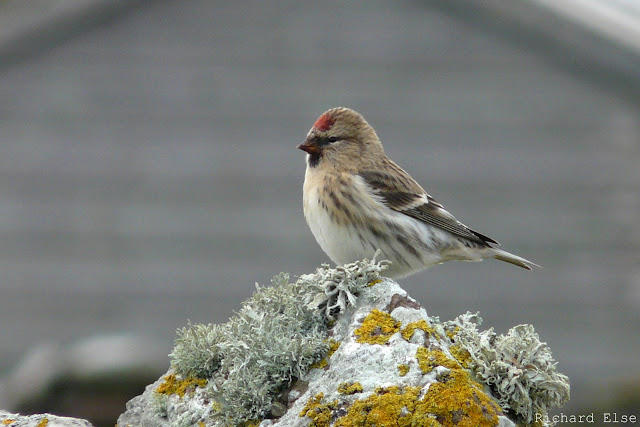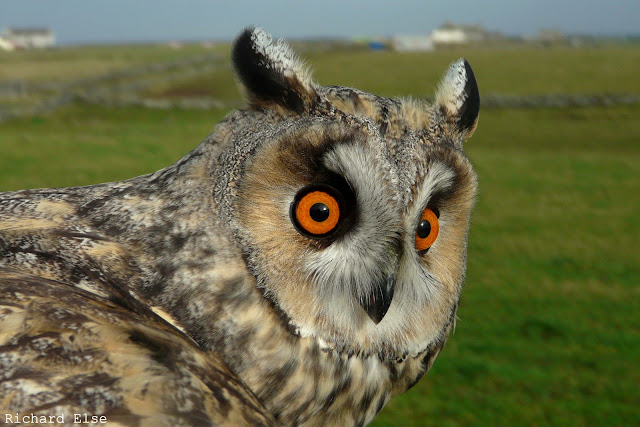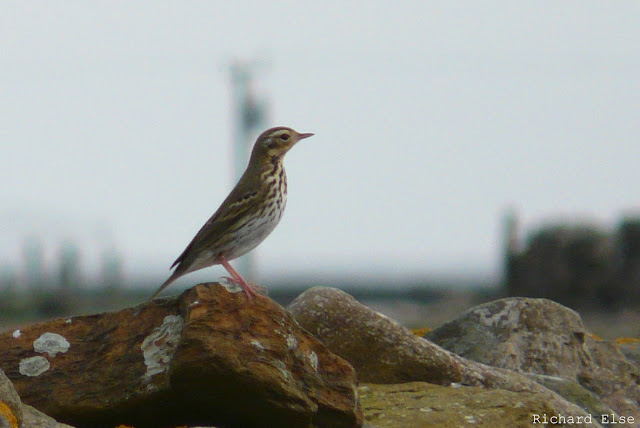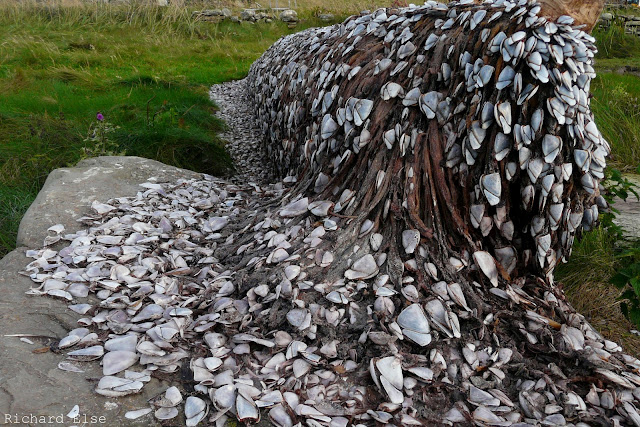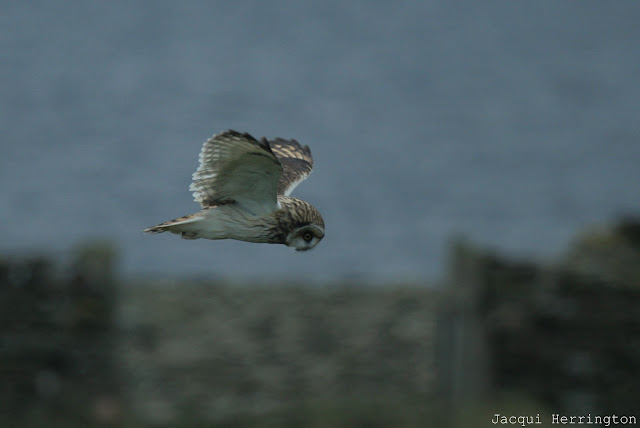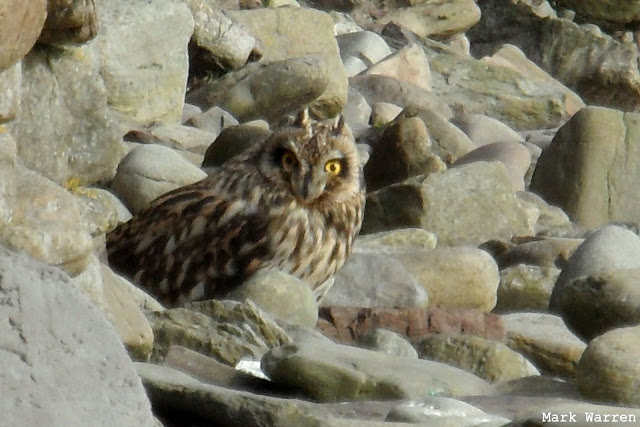Glaucous Gull off Twingness
Monday, December 12, 2011
11th and 12th December
A walk around the north of the island on 11th found more Whooper Swans to have arrived with 13 now on Garso Loch with the 3 Mute Swans. A lone Pink-footed Goose at Rue was also a new arrival, while the 5 Tundra Bean Geese and at least 19 European White-fronted Geese were still around. On Ancum Loch there were now 4 Pochards, while the 2 Scaups remained with 19 Tufted Ducks. The 12th saw some Gull interest at last with a juvenile Iceland Gull and a juvenile Glaucous Gull seen, the latter lingering off Twingness for most of the morning. A Merlin was was seen on both dates and 16 Twite were in the Observatory crop on 12th.
Saturday, December 10, 2011
8th to 10th December
Severe damaging gales on 8th and 9th December meant those 2 days were spent carrying out repairs and paperwork, so there was no bird news to report at all. A wander out on 10th didn't reveal much but 5 Tundra Bean Geese and 41 European White-fronted Geese were present among the Greylags. 11 Long-tailed Ducks were in Linklet Bay, and the Hen Harrier was still hunting Hooking Loch. 4 Snow Buntings, 2 Twite and a handful of thrushes were the only passerines seen.
Wednesday, December 7, 2011
5th to 7th December
The island remains quiet despite the continuing current cold snap with only a few minor cold weather movements observed. The snow and ice remained to 5th when there was an increase in Lapwing numbers to at least 113, including several small groups noted flying south and out to sea in search of unfrozen ground. A few Curlew, Fieldfares and Redwings were also seen to fly south, and 21 Skylarks were counted in suitable habitats. Geese continue to feature with 7 Tundra Bean Geese present on 6th, and a single Greenland White-fronted Goose joined 59 European White-fronted Geese near the school on 7th. One each of Hen Harrier and Merlin remained throughout along with 7 Twite.
Sunday, December 4, 2011
4th December
An unbirdable wet and windy day on 3rd was followed by the first snowfall of the winter overnight and during the morning of the 4th. A pleasant wintry day revealed large numbers of Geese to have left the island with just 314 Greylags counted during a Goose census. 12 Tundra Bean Geese were found though which was an increase on recent days, and 10 European White-fronted Geese were still present. 2 Little Auks, 6 Red-throated Divers and 93 Kittiwakes were seen during a brief half-hour sea-watch. 3 Mute Swans were now present while a check of all the Lochs found increases in a few species of ducks with 21 Shovelers, 11 Goldeneyes and 32 Tufted Ducks notable plus the 2 Scaups and 2 Pochards still. A few thrushes continue to hang-on with 32 Redwing, 8 Fieldfare and 21 Blackbirds in the north along with 5 Robins.
Snow on North Ronaldsay
1st and 2nd December
The 1st was yet another extremely windy day, with a search for interesting Gulls in the afternoon failing to turn up the hoped for 'white-winger'. There was a general increase in numbers though with at least 250 Herring Gulls, 150 Great-black-backed Gulls and 200 Common Gulls found feeding in the swells off either Bridesness or Scottigar. The 6 Whooper Swans remained, as did the 2 Pochards and 2 Scaups with the Tufted Ducks on Ancum Loch. The wind dropped completely overnight for the first time in over two weeks and a few new arrivals were found on the morning of the 2nd. More Geese had arrived with 65 European White-fronted Geese near the school a new record count for the island. Also present were a single Tundra Bean Goose, the lingering Barnacle Goose and at least 570 Greylags, while in the afternoon a flock of 21 Pink-footed Geese flew south. A male Sparrowhawk replaced the female from last week, the Peregrine was still around and 16 Twite were near the observatory.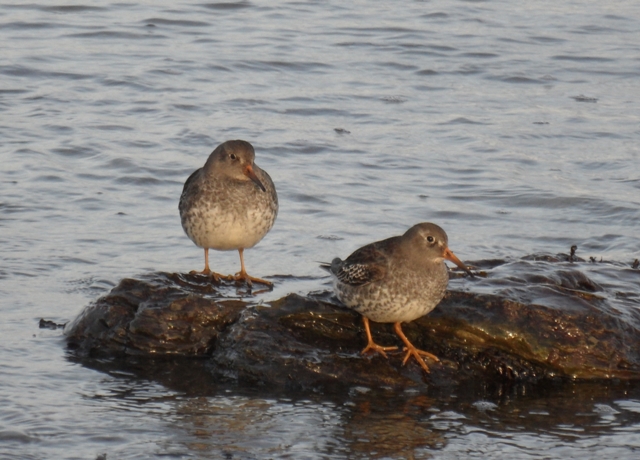

Purple Sandpipers
Friday, December 2, 2011
28th to 30th November
With the gales and hailstorms continuing to batter the island it was still fairly quiet with a Shelduck near Kirbest on 28th the most unusual sighting. 2 Pochards have joined the 2 Scaups and up to 26 Tufted Ducks on Ancum Loch and a Common Scoter was seen off the south end on 29th. 8 Tundra Bean Geese, 17 European White-fronted Geese and the lone Barnacle Goose were still with the Greylag flocks. An immature female Peregrine on 30th was new, while at least 2 Merlins and a Hen Harrier remained. A count of 227 Purple Sandpipers around the coast on 28th was one of the highest of the year, and the wintering flock of Dunlins was up to 48 birds. A venture to the north end of the island on 28th found 6 Woodcocks, 2 of which were seen coming in off the sea and also 2 Black Redstarts including the smart male still near the lighthouse. Otherwise the only other passerines of any note during the period were a Chiffchaff at Brigg, 15 Twite and a Chaffinch near the Observatory and a Lapland Bunting near Holland House, all on the 30th.
Sunday, November 27, 2011
24th to 27th November
A period of atrocious weather was very productive for getting up to date with IPMR and rarity descriptions; It was not, however, very productive for practical field ornithology. A Sparrowhawk on the 24th was just about the only new migrant recorded, and a flock of 34 Long-tailed Ducks sheltering in Linklet Bay on the 27th was a notable count; but the few other birds that were seen were presumably those that had failed to fly south before the gales and hailstorms hit: 10 Tundra Bean Geese were still around on the 24th, up to 27 European White-fronted Geese and the Barnacle Goose were present throughout, and 1 of the Woodpigeons was still near the observatory.
We have done our best to take advantage of the rough weather and have been out catching waders on Gretchen Loch most nights. Several Purple Sandpipers, Turnstones and Golden Plovers have been ringed, along with a few Sanderlings and Ringed Plovers that have been roosting in Nouster Bay.
Thursday, November 24, 2011
23rd November
The best new birds of the day were a very late Wheatear, a Little Auk and a new Little Grebe on Gretchen Loch. Other birds seen included much the same collection of geese as the previous day, 3 Woodcocks, the 2 Woodpigeons and the Blackcap.
Tuesday, November 22, 2011
22nd November
A flock of 19 Whooper Swans flying south down the east side of the island was the highlight of a very quiet day. There were still a Barnacle Goose, 10 Tundra Bean Geese and 37 European White-fronted Geese among the Greylags, the 3 Scaups and 2 Woodpigeons were still present and a Common Redpoll, a Blackcap and a Chiffchaff were at Holland House.
Whooper Swans
21st November
New birds included a smart male Black Redstart, a Peregrine and 2 Hen Harriers. The goose flocks contained 26 European White-fronted Geese, 2 Tundra Bean Geese and a probable Taiga Bean Goose, and the 3 Scaups were still on Ancum Loch.
Sunday, November 20, 2011
20th November
Again, there was little change to report. A couple of Dunnocks, a Chiffchaff, a Brambling and a Chaffinch were the passerine highlights and a Woodpigeon and a Long-eared Owl were still present. The 3 Scaups, 9 Tundra Bean Geese, 23 European White-fronted Geese, 6 Pink-footed Geese and the Barnacle Goose were all recorded again during the census.
19th November
Virtually nothing new was seen, and the only lingering species of note were 17 Tundra Bean Geese, 20 European White-fronted Geese, 2 Woodpigeons and a Long-eared Owl.
Friday, November 18, 2011
18th November
Most of the day's excitement took place in the very small hours of the morning when, during a nocturnal ringing excursion in search of waders and geese, the long-staying and increasingly elusive Baird's Sandpiper made its first appearance for five days in the ringers' torch beams. It was duly trapped, becoming only the third of its kind to be ringed in Britain. The previous two were also caught at bird observatories: Fair Isle in 1991 and Bardsey in 2004.
Although the biometrics fell mostly in the overlap zone, the Baird's Sandpiper was towards the small end of the scale and probably a female.
There was almost nothing new to report from a very quiet day's migrant census, but notable species still present on the island included at least 22 Tundra Bean Geese, 6 Pink-footed Geese, 26 European White-fronted Geese, 1 Barnacle Goose, 3 Scaups, 1 Goosander, 2 Little Gulls and 1 Woodpigeon. The best of the passerines were a Rook, a Dunnock, 2 Chaffinches and a Brambling. All three Long-eared Owls were caught at Holland House: 2 were new birds, the other was ringed here earlier in the week.
Thursday, November 17, 2011
17th November
A second-winter Glaucous Gull and a Mute Swan were the pick of a very thin selection of new birds. A thorough goose count wasn't done, but 6 Tundra Bean Geese, 10 Pink-footed Geese and 10 European White-fronted Geese were seen and 3 Whooper Swans were still present. The Goosander, 3 Scaups and 2 Common Scoters all remained from earlier days, as did a Woodpigeon, a Collared Dove and a Black Redstart. There were 3 Long-eared Owls in Holland House garden, 2 of which might have been fresh migrants.
Wednesday, November 16, 2011
16th November
The only new birds of note were the first Collared Dove since the summer, a new Hen Harrier, a Grey Wagtail and a Blackcap. Remaining birds included a Sparrowhawk, a Little Gull, a Woodpigeon, 2 Black Redstarts and 2 Chiffchaffs.
The number of European White-fronted Geese increased to 48 birds, breaking the island record for that subspecies. Counts of the other geese came to 22 Tundra Bean Geese, 11 Pink-footed Geese and the lone Barnacle Goose. Lingering uncommon ducks included the Goosander, 3 Scaups and 2 Common Scoters.
The number of European White-fronted Geese increased to 48 birds, breaking the island record for that subspecies. Counts of the other geese came to 22 Tundra Bean Geese, 11 Pink-footed Geese and the lone Barnacle Goose. Lingering uncommon ducks included the Goosander, 3 Scaups and 2 Common Scoters.
Tuesday, November 15, 2011
15th November
North Ronaldsay's record Tundra Bean Goose count was toppled once again, with 23 now present around the island. The number of European White-fronted Geese had increased to 39, and a single Greenland White-fronted Goose was found among them. The Barnacle Goose and 2 Pink-footed Geese were also still around and a fourth Scaup joined the 3 already present. Other sightings included a Sparrowhawk, the 2 Woodpigeons and 2 Black Redstarts.
Divers, including a few Great Northern Divers, have been more visible than usual during the relatively calm weather of recent days.
14th November
New birds were in short supply, but a flock of 180 Snow Buntings flying south over the island was the first significant movement of that species for a while. Counts of noteworthy landbirds came to 8 Woodcocks, 2 Woodpigeons, 5 Long-eared Owls, 4 Short-eared Owls, 4 Dunnocks and 2 Black Redstarts. Lingering wildfowl included 28 European White-fronted Geese, 5 Tundra Bean Geese, 2 Scaups, 4 Common Scoters and the Goosander.
Sunday, November 13, 2011
13th November
There were geese galore for a second day, with numbers of the scarcer species increasing even further: Tundra Bean Geese now numbered at least 18, and European White-fronted Geese reached 36. Also among 550 or so Greylag Geese were 7 Pink-footed Geese and a Barnacle Goose. Quite an array of ducks was on display too, including 2 new and 1 lingering Scaup, 3 Common Scoters and the Goosander, as well as multitudes of Wigeons and other common species.
Just 1 adult Little Gull was seen, along with 3 Long-eared Owls, 2 of which were caught and ringed at Holland House. Other odds and ends from the day's log included 8 Grey Herons, 2 Woodpigeons, 1 Peregrine, 2 Hen Harriers, 3 Dunnocks and 5 Chiffchaffs.
Just 1 adult Little Gull was seen, along with 3 Long-eared Owls, 2 of which were caught and ringed at Holland House. Other odds and ends from the day's log included 8 Grey Herons, 2 Woodpigeons, 1 Peregrine, 2 Hen Harriers, 3 Dunnocks and 5 Chiffchaffs.
Tundra Bean Goose
European White-fronted Geese
Saturday, November 12, 2011
12th November
Wildfowl continued to bring plenty of the interest, with a real Anser bonanza enlivening a perfectly clear and sunny afternoon. At least 11 Bean Geese were the highlight, and a record count for the observatory: surprisingly, no more than 2 have ever been recorded here at the same time before. A notable count of 31 European White-fronted Geese was the highest for more than a decade, while 11 Pink-footed Geese and a single Barnacle Goose were also found among the flocks of Greylags. A drake Scaup on Ancum Loch was the best new duck of the day, the Goosander was still on Gretchen Loch, and 7 Common Scoters and 2 Whooper Swans were also seen.
It wasn't all about the quacks though, and a variety of other noteworthy species all added up to quite a satisfying day's birding. A lot of gull activity in Linklet Bay included 6 Little Gulls which, again, somewhat surprisingly, appears to be the island's highest ever count of the species. As well as slightly increased numbers of common waders, the Baird's Sandpiper was still present on the links and a Grey Phalarope was on an inland puddle. A couple of Short-eared Owls and 5 Long-eared Owls were found, and a late Pied Wagtail was the best new passerine.
It wasn't all about the quacks though, and a variety of other noteworthy species all added up to quite a satisfying day's birding. A lot of gull activity in Linklet Bay included 6 Little Gulls which, again, somewhat surprisingly, appears to be the island's highest ever count of the species. As well as slightly increased numbers of common waders, the Baird's Sandpiper was still present on the links and a Grey Phalarope was on an inland puddle. A couple of Short-eared Owls and 5 Long-eared Owls were found, and a late Pied Wagtail was the best new passerine.
The 11 Bean Geese exhibited bills of various shapes and patterns, but all were fairly stocky birds and we believe them to be of the tundra race rossicus. The only previous Bean Goose this year was a lone taiga fabalis bird that arrived in the middle of summer.
We have caught several Long-eared Owls this autumn, but none so easily as this adult male that was found sitting inside the observatory's newest Heligoland trap.
Friday, November 11, 2011
11th November
Common Scoters are normally quite an uncommon sight from North Ronaldsay, but small groups were seen in various places around the island, including a couple that were swimming on Gretchen Loch in the company of a Goosander. Also unusual for the time of year was a lone Shelduck. A Pomarine Skua and a Glaucous Gull were seen during the morning census, and 3 Long-eared Owls were also present.
The Common Scoters (1 shown, top picture, with a Red-breasted Merganser) and the Goosander (lower picture) were among a busy array of ducks on Gretchen Loch that also included a Pintail, 5 Goldeneyes and 140 Wigeons.
The Common Scoters (1 shown, top picture, with a Red-breasted Merganser) and the Goosander (lower picture) were among a busy array of ducks on Gretchen Loch that also included a Pintail, 5 Goldeneyes and 140 Wigeons.
Thursday, November 10, 2011
10th November
Another exodus of birds took place during the cloudy, but still very bright, moonlit night, with the numbers of all thrush species decreasing by more than fifty percent by the morning. A Rook, 30 Robins and a Wheatear were among a diminished selection of small migrants, and 34 Woodcocks and 3 Pochards were also recorded. There was more of interest among the contingent of long-staying non-passerines: the Baird's Sandpiper made a reappearance after a week's apparent absence, the Brent Goose was at the north coast, and both the Little Gull and the Swallow were seen again.
Little Gull
Wednesday, November 9, 2011
9th November
An increase in the south-easterly wind and overcast conditions resulted in another substantial fall of thrushes on the island, along with a thin assortment of other migrants that included the first 2 Waxwings since January and a Lesser Whitethroat. The day's census counts of thrushes came to 886 Blackbirds, 563 Fieldfares, 245 Redwings, 46 Song Thrushes and a Ring Ouzel; totals of other passerines included 60 Robins, 6 Black Redstarts, 2 Wheatears, 15 Blackcaps, 4 Chiffchaffs, 4 Goldcrests, 2 Chaffinches, a Greenfinch and the same tardy Swallow.
At least 49 Woodcocks were found on census, as well as 4 Short-eared Owls and 3 Long-eared Owls. A Pale-bellied Brent Goose (probably the bird from earlier in the week) was on Tor Ness, 11 Common Scoters were seen offshore and the Little Gull was still touring around the island.
At least 49 Woodcocks were found on census, as well as 4 Short-eared Owls and 3 Long-eared Owls. A Pale-bellied Brent Goose (probably the bird from earlier in the week) was on Tor Ness, 11 Common Scoters were seen offshore and the Little Gull was still touring around the island.
Long-eared Owl
8th November
Besides an increase in the number of thrushes, comprising 103 Blackbirds, 275 Fieldfares, 167 Redwings and 9 Song Thrushes, there wasn't a lot to report. The Little Gull, 17 Robins and a Black Redstart remained from earlier days, 3 Short-eared Owls were seen and the lingering Swallow still hadn't moved on.
Monday, November 7, 2011
7th November
The glorious spring-like weather continued but there were only a few new arrivals. Wildfowl numbers increased slightly with 213 Wigeons and 112 Teal counted. 2 Common Scoters were on the sea but the highlight was the second Pale-bellied Brent Goose of the autumn which flew past the north end. Passerine numbers continue to dwindle, although a Grey Wagtail was new, while 13 Robins, 2 Black Redstarts, 6 Blackcaps, 4 Chiffchaffs and 2 Lapland Buntings remained from previous days.
6th November
Another pleasant but quiet day, with a visible clear-out of migrants overnight: just two new birds were trapped and ringed at Holland House during the morning's ringing session. A whole-island goose census revealed 653 Greylags to be present and with them 2 Pink-footed Geese. A couple of Pochards on Ancum Loch and yet another late Swallow were the only birds of note.
Saturday, November 5, 2011
5th November
The highlights of a fine, calm and sunny day were a juvenile Pomarine Skua flying over the island, 2 Little Auks and 3 Common Scoters offshore, and a mass arrival of 43 Tufted Ducks on Bridesness Loch. An arrival of Whooper Swans in the late afternoon comprised 13 birds on Gretchen and Garso Lochs. The Desert Wheatear remained on the west coast in the morning.
Desert Wheatear
4th November
The Desert Wheatear was still on the west coast of the island, and both the Iceland Gull and the Little Gull were seen again. At least 8 Short-eared Owls and 1 Long-eared Owl were seen, and 15 Woodcocks were found scattered around the island. A Ring Ouzel and a Little Auk were probably the most notable new species, while a charm of 6 Goldfinches at Holland House was only a single bird short of equalling the island's highest ever count of the species.
This particularly dingy specimen of a Ring Ouzel was the first to be ringed here this year. Of about 95 species that we have ringed in 2011, three have been additions to the observatory's all-time ringing list: White-fronted Goose, Grey Plover and Pechora Pipit.
Thursday, November 3, 2011
3rd November
Although a day of frustratingly difficult, windy and wet birding conditions got off to an exasperating start with a large (although perhaps not that large) pipit sp. and a warbler (probably Acrocephalus) sp. both evading identification in the irises at Ancum Loch, all was forgotten a short time later when the call came through of a male Desert Wheatear on the west coast. This is a new species for North Ronaldsay and the fourth record for Orkney.
Desert Wheatear
There had clearly been another arrival of thrushes on the island, with 1196 Fieldfares, 304 Redwings, 219 Blackbirds, 33 Song Thrushes and 2 Ring Ouzels recorded; and a variety of other passerines included a late Swallow, 6 Black Redstarts, 10 Robins, 5 Wheatears and the usual Short-toed Lark. A late Great Skua, a juvenile Iceland Gull and an adult Little Gull were seen, as well as 12 Woodcocks, 2 Short-eared Owls and a Long-eared Owl.
Wednesday, November 2, 2011
2nd November
A windy day didn't leave much worth reporting. The Baird's Sandpiper was still on the golf course and there was still a Short-eared Owl near the airfield, but the best new birds were a Little Gull in Nouster Bay and a Grey Wagtail. Numbers of most other species remained much the same, although the small group of Greenfinches at Holland house increased to 6 birds.
Tuesday, November 1, 2011
1st November
Odds and ends continued to make landfall on the coasts, and a new Short-toed Lark was found in the rough fields at the north of the island while the lingering bird was still at Bewan. A male Stonechat near the lighthouse was probably the most interesting of the other new migrants, and counts of the more regular species included 31 Robins, 9 Black Redstarts, 1 Dunnock, 15 Blackcaps, 7 Chiffchaffs, 6 Goldcrests, 3 Chaffinches, 1 Brambling, 3 Greenfinches and 4 Goldfinches. The day's birds of prey were 3 Hen Harriers, a Sparrowhawk, 2 Merlins and a Short-eared Owl.
Short-eared Owl
Monday, October 31, 2011
31st October
A variety of new arrivals made for a reasonably interesting day's census, the highlights of which were 2 Great Grey Shrikes. Also of interest were a rather late Swallow and an equally late Common Redstart. Counts of the more every-day species, many of which would be lingering birds from earlier in the week, came to 18 Robins, 7 Black Redstarts, the same Whinchat, 3 Wheatears, 5 Goldcrests, 1 Blackcap, 8 Chiffchaffs, 2 Bramblings, 3 Greenfinches, 3 Goldfinches and a Lesser Redpoll. The Mistle Thrush and 2 Yellowhammers were still around, as was the Short-toed Lark, which is starting to look a little weather-beaten. Thrushes were still present in reasonable numbers, with 515 Fieldfares, 173 Blackbirds, 157 Redwings and 19 Song Thrushes logged.
The Baird's Sandpiper remained on the links, while a noticeable increase in Purple Sandpipers brought the day's count to 109.
The Baird's Sandpiper remained on the links, while a noticeable increase in Purple Sandpipers brought the day's count to 109.
One of the Great Grey Shrikes was discovered as it devoured one of the local mice in one of the observatory's Heligoland traps.
30th October
Small numbers of migrants continued to arrive, including a late Garden Warbler, a Mistle Thrush and a third Yellowhammer joining the previous day's 2. Numbers of other passerine species included 18 Robins, 4 Black Redstarts, 6 Blackcaps, 4 Chiffchaffs, 5 Goldcrests, 2 Goldfinches and a Greenfinch; 2 Hen Harriers, a Sparrowhawk, a Merlin and 4 Woodcocks were the best of the non-passerines. And the Short-toed Lark was still there as usual.
Sunday, October 30, 2011
A New North Ronaldsay Year-list Record!
Since early in the spring, an aim of ours has been to record more species on the island in 2011 than have been seen in any other year. The previous best year-list was an impressive 215 species seen in 2003, but we thought that, with a bit of extra observer coverage, this was a reachable target.
Now, after carefully double-checking the list, we can proudly announce that 2011 has officially been the best ever birding year on North Ron. The Firecrest earlier in the week was species number 216 for the year, while Dusky Warbler and Baird's Sandpiper have since taken the list to a record-smashing 218! With two months still to go, and quality birds still arriving, just how high can we set the year-listing bar?
And we've still not had a Buzzard.
Now, after carefully double-checking the list, we can proudly announce that 2011 has officially been the best ever birding year on North Ron. The Firecrest earlier in the week was species number 216 for the year, while Dusky Warbler and Baird's Sandpiper have since taken the list to a record-smashing 218! With two months still to go, and quality birds still arriving, just how high can we set the year-listing bar?
And we've still not had a Buzzard.
Saturday, October 29, 2011
29th October
The surprising highlight of the day was a juvenile Baird's Sandpiper with the Dunlins and Ringed Plovers on the golf course. This record, slightly later in the year than might be expected, is only the second for Orkney; the only previous bird was also on North Ronaldsay in early October 1993.
Besides the sandpiper, there was relatively little change in the number of birds present. The Dusky Warbler was still present, while counts of other small migrants came to 17 Robins, 4 Black Redstarts, 3 Wheatears, 777 Fieldfares, 254 Redwings, 159 Blackbirds, 26 Song Thrushes, 7 Blackcaps, 2 Chiffchaffs, 4 Goldcrests and a Yellowhammer. A variety of finches included 29 Bramblings, 2 Greenfinches, a Goldfinch and 3 Common Redpolls. A Long-eared Owl and 4 Woodcocks were the pick of the non-passerines.
Dusky Warbler
Friday, October 28, 2011
28th October
Numbers of most migrants continued to fall slightly, and fewer new birds seemed to have arrived than in previous days. The Dusky Warbler remained in its favoured strip of wilted irises near Burray, showing quite well at times. The ever-present Short-toed Lark also remained, along with a Goldfinch, a Whinchat, 5 Black Redstarts, 2 Wheatears and 2 Woodpigeons. Counts of other migrants came to 2 Yellowhammers, 16 Robins, 4 Blackcaps, 7 Chiffchaffs and 10 Goldcrests. Thrush numbers had dropped to 448 Fieldfares, 145 Blackbirds, 100 Redwings and 18 Song Thrushes.
Although quite confiding, the Dusky Warbler was often difficult to see as it scurried around Locustella-like at the bottom of the irises near 'P.G.Tips Field', a patch of dense canary grass which is just to the west of 'Great Snipe Land'.
Thursday, October 27, 2011
27th October
After watching flocks of thrushes departing south out to sea the previous evening, it was surprising to find plenty of birds still present in the morning, although numbers of some species were noticeably diminished. There were also some fresh migrants to be found, the highlight of which was North Ronaldsay's second Dusky Warbler. Almost as rare, in an island context at least, was a Firecrest near Sangar - this is only the fourth record of the species here.
Thrushes were still very conspicuous, with 1052 Fieldfares, 308 Redwings, 182 Blackbirds and 51 Song Thrushes logged. Of the other migrants, a count of 12 Black Redstarts was particularly noteworthy as it is the most ever recorded on the island at once. An influx of Skylarks brought the day's count to 153 birds, while other small migrants included 23 Robins, a Whinchat, 8 Blackcaps, 9 Chiffchaffs, 13 Goldcrests, 17 Jackdaws, a Greenfinch, a Goldfinch, a Common Redpoll and a Lesser Redpoll.
Thrushes were still very conspicuous, with 1052 Fieldfares, 308 Redwings, 182 Blackbirds and 51 Song Thrushes logged. Of the other migrants, a count of 12 Black Redstarts was particularly noteworthy as it is the most ever recorded on the island at once. An influx of Skylarks brought the day's count to 153 birds, while other small migrants included 23 Robins, a Whinchat, 8 Blackcaps, 9 Chiffchaffs, 13 Goldcrests, 17 Jackdaws, a Greenfinch, a Goldfinch, a Common Redpoll and a Lesser Redpoll.
Woodcocks have arrived in numbers in the last few days, including this individual ringed at Holland House.
Wednesday, October 26, 2011
26th October
After strong south-easterly wind and steady rain overnight, it was not surprising to find the whole island, particularly the leeward coasts, alive with thrushes and other migrants in the morning. There was nothing particularly rare apart from the previous day's Siberian Stonechat and the long-term resident Short-toed Lark, but the numbers of common species were quite impressive.
Counts of thrushes amounted to 1530 Fieldfares, 1093 Blackbirds (the observatory's highest ever count of this species), 470 Redwings, 109 Song Thrushes, 1 Mistle Thrush and, at long last, the first Ring Ouzel of the autumn. A good variety of less numerous passerines included 6 Black Redstarts, 27 Robins, 5 Wheatears, 107 Skylarks, 19 Blackcaps, 6 Chiffchaffs, 10 Goldcrests, 16 Jackdaws, 18 Bramblings, 2 Chaffinches, 2 Greenfinches, 1 Goldfinch, 1 Common Redpoll and 2 Yellowhammers.
Non-passerines were no less diverse and included 31 Woodcocks, 4 Woodpigeons, 2 Long-eared Owls, 2 Short-eared Owls, 4 Sparrowhawks and 7 Grey Herons. A juvenile Long-tailed Skua was lingering off the north of the island, while a juvenile Pomarine Skua was seen harassing Great Black-backed Gulls near Twingness. The first 2 Goldeneyes since early spring flew past at sea, 24 Barnacle Geese were roosting with the gulls on Tor Ness and a migrant Moorhen looked out of place amongst a flock of Blackbirds on the west coast.
Counts of thrushes amounted to 1530 Fieldfares, 1093 Blackbirds (the observatory's highest ever count of this species), 470 Redwings, 109 Song Thrushes, 1 Mistle Thrush and, at long last, the first Ring Ouzel of the autumn. A good variety of less numerous passerines included 6 Black Redstarts, 27 Robins, 5 Wheatears, 107 Skylarks, 19 Blackcaps, 6 Chiffchaffs, 10 Goldcrests, 16 Jackdaws, 18 Bramblings, 2 Chaffinches, 2 Greenfinches, 1 Goldfinch, 1 Common Redpoll and 2 Yellowhammers.
Non-passerines were no less diverse and included 31 Woodcocks, 4 Woodpigeons, 2 Long-eared Owls, 2 Short-eared Owls, 4 Sparrowhawks and 7 Grey Herons. A juvenile Long-tailed Skua was lingering off the north of the island, while a juvenile Pomarine Skua was seen harassing Great Black-backed Gulls near Twingness. The first 2 Goldeneyes since early spring flew past at sea, 24 Barnacle Geese were roosting with the gulls on Tor Ness and a migrant Moorhen looked out of place amongst a flock of Blackbirds on the west coast.
Tuesday, October 25, 2011
25th October
Despite the weather verging on unbirdably windy, the same south-easterly winds delivered plenty of new migrants to the island. The bird of the day, a male Siberian Stonechat near Hooking Loch, spent the day sheltering from the gales along a low wall and hiding in the adjacent long grass. This is about the 8th record for North Ronaldsay, and the first since 2001.
A Goshawk at Holland House was equally rare from a North Ronaldsay perspective, there being 7 previous records of this species too, although it was the third record of the year. Thrushes made up the bulk of the migrant numbers, with log counts totalling 670 Fieldfares, 195 Blackbirds, 179 Redwings and 22 Song Thrushes. The best of the other passerines were a Greenfinch, a Goldfinch, 2 Common Redpolls, 5 Bramblings, a Blackcap, 6 Wheatears and 3 Robins. Other oddments included a Woodpigeon, a Short-eared Owl, 5 Woodcocks, a Hen Harrier, 2 Sparrowhawks and a Merlin.
Siberian Stonechat: Yes, that blurry black and orange thing in front of the nearly-in-focus bit of grass and to the left of the highly obtrusive foreground fencepost.
A Goshawk at Holland House was equally rare from a North Ronaldsay perspective, there being 7 previous records of this species too, although it was the third record of the year. Thrushes made up the bulk of the migrant numbers, with log counts totalling 670 Fieldfares, 195 Blackbirds, 179 Redwings and 22 Song Thrushes. The best of the other passerines were a Greenfinch, a Goldfinch, 2 Common Redpolls, 5 Bramblings, a Blackcap, 6 Wheatears and 3 Robins. Other oddments included a Woodpigeon, a Short-eared Owl, 5 Woodcocks, a Hen Harrier, 2 Sparrowhawks and a Merlin.
24th October
A few more thrushes came in on gale-force south-easterly winds, with 129 Fieldfares, 85 Blackbirds and 56 Redwings logged. Despite the previous evening's promising signs, other passerines of interest were very thin on the ground and amounted to little more than a Whinchat, 5 Bramblings and 2 Jackdaws. A Short-eared Owl, a Merlin and a Sparrowhawk were seen on the land, and a Pomarine Skua was off the north end of the island.
Sunday, October 23, 2011
23rd October
A Slavonian Grebe on Hooking Loch and a Grey Phalarope seen flying over Holland House were the highlights of a quiet morning, but the wind backing slightly to the east in the afternoon produced an almost immediate arrival of small numbers of passerines. A Yellow-browed Warbler with a ring on its leg was interesting, it being more than 2 weeks since the previous sighting of the species here, while 13 Blackcaps, 2 Chiffchaffs, 2 Bramblings and a Goldfinch also appeared after midday. Thrush counts came to 112 Fieldfares, 44 Redwings, 2 Song Thrushes, 50 Blackbirds and the autumn's first Mistle Thrush. The Short-toed Lark and the Jackdaw both remained, an Arctic Tern was in Nouster Bay and a Short-eared Owl was near the lighthouse.
Today's Slavonian Grebe is the third record this year, after one in mid February and a bird still partly in breeding plumage in September.
Saturday, October 22, 2011
22nd October
The day's highlight was a juvenile Long-tailed Skua seen flying around near Garso, while at least 3 Pomarine Skuas, 3 Great Skuas and a Little Auk passed by the seawatching hide. The Short-toed Lark, now resident in the same spot for over a month, was still by Bewan Loch. Otherwise, it was a very quiet day, with just 79 Fieldfares remaining from the previous day's influx and almost no new migrants.
21st October
An arrival of 566 Fieldfares and 70 Redwings in the fields around Twingness accounted for nearly all the day's passerine migrants, with little besides a lone Jackdaw to be seen in the rest of the island. The autumn's first Pale-bellied Brent Goose and Iceland Gull were the best of the non-passerines, and a couple of Woodcocks were also seen.
Brent Goose
Thursday, October 20, 2011
20th October
In much calmer and more pleasant conditions, a short morning seawatch finally produced the first Long-tailed Skua of the year, as well as a juvenile Glaucous Gull, an Arctic Skua, 5 Great Skuas, 2 Sooty Shearwaters and 248 Kittiwakes. Landbird interest was mostly limited to finches, with 2 Goldfinches at Senness, a large arrival of Twite taking the day-count to 119, the Greenland Redpoll still at Holland House and a Common Redpoll of a different variety at Garso.
The Garso Redpoll was quite distinctive in appearance with a large, though faintly streaked, white rump, and could be of Icelandic origin.
Wednesday, October 19, 2011
19th October
Just about the only migrant worth mentioning from a cold and very windy day was a Greenland Common Redpoll at Holland House. This is the first record of a rostrata bird on the island this year.
Tuesday, October 18, 2011
18th October
The best new birds were a couple of confiding Grey Phalaropes feeding in the surf near Howar. There was little else to report apart from the long-staying Short-toed Lark still at Bewan.
Grey Phalaropes
17th October
The highlights, if they can be described as such, of another very quiet day of strong westerly wind and showers were a Jackdaw, a Carrion Crow and a Kestrel. Other passerines on the island, most of which arrived a few days or more previously, included a Robin, a Whinchat, 14 Fieldfares, 19 Redwings, a Pied Wagtail, 3 Blackcaps, a Chiffchaff, a Goldcrest, 2 Chaffinches and 10 Bramblings.
A small flock of Bramblings has been frequenting the Holland House gardens and nearby stubble fields for a few days.
Sunday, October 16, 2011
16th October
Although there were few new birds to report, it was quite a good day for birds of prey, with 2 Sparrowhawks, 2 Merlins, a Peregrine, a Hen Harrier, 2 Short-eared Owls and a Long-eared Owl seen. A Grey Phalarope was off the north of the island, the first Mute Swan of the autumn appeared on Ancum Loch and a Little Auk was found swimming on Bewan Loch. The resident Short-toed Lark made another appearance in its usual spot, and the previous day's Common Rosefinch was still around.
Little Auk
15th October
A little bit of passerine immigration was evident, although, besides 16 Blackcaps dotted around the island, the only notable species was a new juvenile Common Rosefinch at Holland House. A Long-eared Owl and a Short-eared Owl were present and 3 Woodcocks were found. The Great Grey Shrike was seen briefly in the morning, while the Olive-backed Pipit continued to show well at Westness all day.
Friday, October 14, 2011
14th October
Seen flying south down the west coast early in the morning, the second Goshawk of the year was the best bird of the day. At least 3 Sparrowhawks were also seen, along with 2 Merlins, 4 Short-eared Owls and a Long-eared Owl. A couple of Woodpigeons were also new, and 3 Woodcocks were the only notable waders.
Slightly more passerine migrants were present, including 18 Goldcrests, 1 Lesser Whitethroat, 5 Blackcaps, 4 Chiffchaffs, 4 Robins, 1 Dunnock and 63 Fieldfares. The number of Bramblings reached 15, and other finches included 3 Redpolls, 2 Siskins and a Chaffinch. Both the Olive-backed Pipit and the Great Grey Shrike were still around.
Slightly more passerine migrants were present, including 18 Goldcrests, 1 Lesser Whitethroat, 5 Blackcaps, 4 Chiffchaffs, 4 Robins, 1 Dunnock and 63 Fieldfares. The number of Bramblings reached 15, and other finches included 3 Redpolls, 2 Siskins and a Chaffinch. Both the Olive-backed Pipit and the Great Grey Shrike were still around.
The Long-eared Owl was the highlight of a short mist-netting session at Holland House.
Thursday, October 13, 2011
13th October
After a fairly quiet morning a few birds seemed to begin arriving at around midday, one of which was a smart Olive-backed Pipit at Westness. Later in the afternoon the island year-list gained another species in the shape of a Great Grey Shrike near the airfield. A few common migrants that appeared during the day included 8 Goldcrests and 8 Bramblings, while more unusual sightings included a Short-eared Owl, a Woodcock and 3 Pomarine Skuas, 2 of which flew low down along the links.
Today's Olive-backed Pipit is the 16th to be recorded on North Ronaldsay.
Great Grey Shrike
Wednesday, October 12, 2011
12th October
In terms of landbirds, this was just about the quietest day of the autumn, with nothing more than a Greenfinch worth mentioning.
Thankfully, seabird passage provided a bit more to write about. The star bird, making its appearance early in the afternoon, was our second Fea's Petrel of the year. This is the fourth record of the species for North Ronaldsay, and the third in just under a year. Other notable seabirds seen during 6 and a half hours in the hide included 2 Pomarine Skuas, a Grey Phalarope, a Little Auk and 2 Common Scoters. A day total of 1415 Gannets was only just shy of the highest ever count here, while other counts came to 269 Fulmars, 23 Sooty Shearwaters, 1 Manx Shearwater, 1 Storm Petrel and 812 Kittiwakes.
Thankfully, seabird passage provided a bit more to write about. The star bird, making its appearance early in the afternoon, was our second Fea's Petrel of the year. This is the fourth record of the species for North Ronaldsay, and the third in just under a year. Other notable seabirds seen during 6 and a half hours in the hide included 2 Pomarine Skuas, a Grey Phalarope, a Little Auk and 2 Common Scoters. A day total of 1415 Gannets was only just shy of the highest ever count here, while other counts came to 269 Fulmars, 23 Sooty Shearwaters, 1 Manx Shearwater, 1 Storm Petrel and 812 Kittiwakes.
11th October
Although the seawatching was quite slow, there was slightly more happening than there was on the land. Numbers of the common species were low, but 5 Grey Phalaropes and a Little Auk were recorded passing by Dennis Head and 21 Red-breasted Mergansers were dotted around the coast. The only landbirds worth mentioning were 196 lingering Redwings and 16 Fieldfares.
Monday, October 10, 2011
10th October
In more windy westerly weather, the most interesting sightings all involved wildfowl. Pick of the bunch was a drake Velvet Scoter, a very scarce species here, that flew past the old beacon heading east during the morning. Greylag Geese were scattered around the island, with 12 Barnacle Geese, 5 Pink-footed Geese and a European White-fronted Goose arriving during the day and the lingering Greenland White-fronted Goose still in residence at the north of the island.
A Grey Phalarope was at Quoy Banks in the morning, and a presumed different individual was at Bridesness a short time later. The long-staying Short-toed Lark, reappearing after 6 days, was the best passerine. A Common Redpoll was seen and counts of thrushes came to 29 Fieldfares and 355 Redwings.
A Grey Phalarope was at Quoy Banks in the morning, and a presumed different individual was at Bridesness a short time later. The long-staying Short-toed Lark, reappearing after 6 days, was the best passerine. A Common Redpoll was seen and counts of thrushes came to 29 Fieldfares and 355 Redwings.
As nobody has taken any usable bird photos in the last few days, I finally get chance to use this picture of an impressive cluster of Goose Barnacles taken back in September. In the autumn, these creatures finish their amazing transformation into Barnacle Geese, lose their protective shells, detach themselves from their driftwood anchor and take flight, ready to spend the winter grazing with other types of geese. The Barnacle Geese seen on the island today must be among the first to have completed their metamorphosis this year, but, by the looks of this picture, we can expect many more in the coming weeks.
Reference: Cambrensis, Giraldus. Of barnacles, which grow from fir timber, and their nature (1188).
9th October
A big arrival of thrushes involved 95 Fieldfares, 12 Song Thrushes and more than 2000 Redwings, most of which were concentrated around the south-western part of the island. The crop field at Kirbest held 100 Skylarks and among them, the bird of the day, a Woodlark. There were few other passerine migrants, although 8 Bramblings and a Siskin were seen and the Snow Bunting count reached 332 birds.
A Grey Phalarope at Westness was an addition to the year-list, and either it or a second bird was seen lingering off the west coast later in the afternoon. The first Woodcock of the autumn was near Twingness, while 17 Jack Snipe was a clear increase on previous days. Sea passage was much slower than the day before, with just 1 Little Auk and only a small number of Fulmars and Shearwaters passing by, and the only notable wildfowl movement was 21 Whooper Swans and 122 Pink-footed Geese.
A Grey Phalarope at Westness was an addition to the year-list, and either it or a second bird was seen lingering off the west coast later in the afternoon. The first Woodcock of the autumn was near Twingness, while 17 Jack Snipe was a clear increase on previous days. Sea passage was much slower than the day before, with just 1 Little Auk and only a small number of Fulmars and Shearwaters passing by, and the only notable wildfowl movement was 21 Whooper Swans and 122 Pink-footed Geese.
Sunday, October 9, 2011
8th October
The wind finally dropped; the rain abated; the mist nets were opened with high hopes of trapping all the Catharus thrushes that had spent the week sheltering unseen under the fuchsia bushes; but the most interesting passerine of the day, winning by a clear head, was a single Dunnock.
Sea passage was a bit more interesting. The species composition had a distinctly late-autumn feel, with 25 Little Auks, a juvenile Glaucous Gull and 3 Long-tailed Ducks indicating that winter is not that far away, and a total count of 2759 Fulmars including 28 northern 'blue' birds among them. Other counts from 5 and a half hours in the hide included 135 Sooty Shearwaters, 17 Manx Shearwaters, 583 Gannets, a Common Scoter, 9 Great Skuas, 194 Kittiwakes and 350 or so mixed Razorbills and Guillemots.
Sea passage was a bit more interesting. The species composition had a distinctly late-autumn feel, with 25 Little Auks, a juvenile Glaucous Gull and 3 Long-tailed Ducks indicating that winter is not that far away, and a total count of 2759 Fulmars including 28 northern 'blue' birds among them. Other counts from 5 and a half hours in the hide included 135 Sooty Shearwaters, 17 Manx Shearwaters, 583 Gannets, a Common Scoter, 9 Great Skuas, 194 Kittiwakes and 350 or so mixed Razorbills and Guillemots.
Friday, October 7, 2011
7th October
It was another quiet day, although 4 White-fronted Geese and a Pomarine Skua flying past were noteworthy sightings. A Common Redpoll was probably new, while other passerines included a Barred Warbler, a Common Rosefinch, a Whinchat and a Robin.
Plenty of the common waders have been around recently, including Purple Sandpipers in several rocky areas of coastline.
The Whinchat has been resident around the observatory traps for most of the week, somehow evading capture so far.
6th October
In a monkey's wedding day of sunshine, heavy showers, wind, rainbows and hailstorms admixed, avian diversity couldn't quite match that of the weather. There were hardly any geese on the move, but at least 16 Whooper Swans were on the island. A Barred Warbler near Ancum Loch could well have been the bird from the previous week. A Short-eared Owl at the north of the island might also have been the bird from earlier in the week, and 3 Grey Plovers were probably all long-stayers. There did seem to have been a considerable increase in the number of Snow Buntings, with about 200 dotted around the island.
Short-eared Owl
Thursday, October 6, 2011
5th October
By far the year's biggest movement of geese began early in the morning and continued throughout the day, skein after skein passing south overhead. Of over 3000 birds counted, around half of them were Pink-footed Geese; the other half were Greylags. Other passage wildfowl included the first 2 Goosanders of the year and 3 Whooper Swans, while the Greenland White-fronted Goose was still at Bewan.
The autumn's first Fieldfare, making its appearance a bit later than expected, was probably the most notable passerine. A Lesser Whitethroat, 2 Yellow-browed Warblers, 3 Chaffnches and a Brambling were also seen.
The autumn's first Fieldfare, making its appearance a bit later than expected, was probably the most notable passerine. A Lesser Whitethroat, 2 Yellow-browed Warblers, 3 Chaffnches and a Brambling were also seen.
Wednesday, October 5, 2011
4th October
Less windy, although not by much, the day's birding did reveal a few noteworthy species, although most passerines were presumably long-stayers. The best new birds were a juvenile Little Gull in Linklet Bay and a Short-eared Owl at the north of the island; the best of the non-movers were the Short-toed Lark, a Common Rosefinch, a Yellow-browed Warbler, 2 Curlew Sandpipers and the Greenland White-fronted Goose.
Other odds and ends included 3 Bramblings, 2 Chaffinches, 7 Blackcaps, a Whinchat, a Swallow, a Common Tern and 3 Arctic Terns.
Other odds and ends included 3 Bramblings, 2 Chaffinches, 7 Blackcaps, a Whinchat, a Swallow, a Common Tern and 3 Arctic Terns.
Short-eared Owl
Subscribe to:
Posts (Atom)

